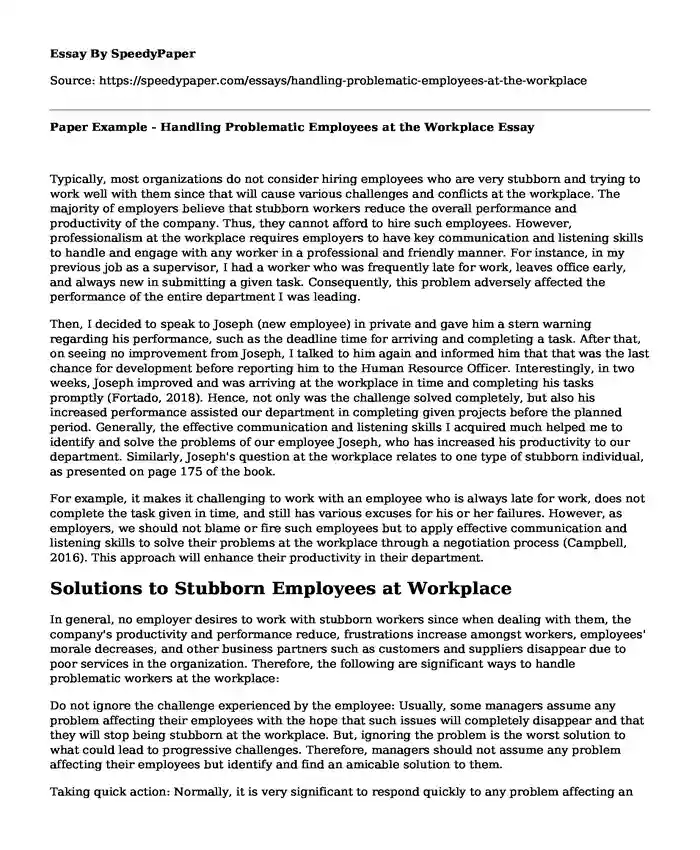
| Type of paper: | Essay |
| Categories: | Human resources Problem solving Conflict management |
| Pages: | 3 |
| Wordcount: | 663 words |
Typically, most organizations do not consider hiring employees who are very stubborn and trying to work well with them since that will cause various challenges and conflicts at the workplace. The majority of employers believe that stubborn workers reduce the overall performance and productivity of the company. Thus, they cannot afford to hire such employees. However, professionalism at the workplace requires employers to have key communication and listening skills to handle and engage with any worker in a professional and friendly manner. For instance, in my previous job as a supervisor, I had a worker who was frequently late for work, leaves office early, and always new in submitting a given task. Consequently, this problem adversely affected the performance of the entire department I was leading.
Then, I decided to speak to Joseph (new employee) in private and gave him a stern warning regarding his performance, such as the deadline time for arriving and completing a task. After that, on seeing no improvement from Joseph, I talked to him again and informed him that that was the last chance for development before reporting him to the Human Resource Officer. Interestingly, in two weeks, Joseph improved and was arriving at the workplace in time and completing his tasks promptly (Fortado, 2018). Hence, not only was the challenge solved completely, but also his increased performance assisted our department in completing given projects before the planned period. Generally, the effective communication and listening skills I acquired much helped me to identify and solve the problems of our employee Joseph, who has increased his productivity to our department. Similarly, Joseph's question at the workplace relates to one type of stubborn individual, as presented on page 175 of the book.
For example, it makes it challenging to work with an employee who is always late for work, does not complete the task given in time, and still has various excuses for his or her failures. However, as employers, we should not blame or fire such employees but to apply effective communication and listening skills to solve their problems at the workplace through a negotiation process (Campbell, 2016). This approach will enhance their productivity in their department.
Solutions to Stubborn Employees at Workplace
In general, no employer desires to work with stubborn workers since when dealing with them, the company's productivity and performance reduce, frustrations increase amongst workers, employees' morale decreases, and other business partners such as customers and suppliers disappear due to poor services in the organization. Therefore, the following are significant ways to handle problematic workers at the workplace:
Do not ignore the challenge experienced by the employee: Usually, some managers assume any problem affecting their employees with the hope that such issues will completely disappear and that they will stop being stubborn at the workplace. But, ignoring the problem is the worst solution to what could lead to progressive challenges. Therefore, managers should not assume any problem affecting their employees but identify and find an amicable solution to them.
Taking quick action: Normally, it is very significant to respond quickly to any problem affecting an employee at the workplace before it rises further, which will affect the productivity of the entire organization (Campbell, 2016). Eventually, it is the ultimate duty of the employer to respond appropriately to solve the existing problem amongst the employees, as this will increase the productivity of the employee to the organization's overall performance.
Helping the problematic worker to regain his productivity level: Once the stubborn employee starts to understand the effects of negative behaviors and that they are not tolerated in the company, the manager should start coaching or communicating with the employee regarding the consequences of harmful behaviors at the workplace (Fortado, 2018). Besides, the managers should advise them on the importance of adopting and displaying more appropriate behaviors at the workplace. As a result, this will highly encourage productivity.
References
Campbell, D. J. (2016). The proactive employee: Managing workplace initiative. Academy of Management Perspectives, 14(3), 52-66.
Fortado, B. (2018). The metamorphosis of workplace conflict. Human Relations, 54(9), 1189-1221.
Cite this page
Paper Example - Handling Problematic Employees at the Workplace. (2023, May 02). Retrieved from https://speedypaper.com/essays/handling-problematic-employees-at-the-workplace
Request Removal
If you are the original author of this essay and no longer wish to have it published on the SpeedyPaper website, please click below to request its removal:
- Free Paper Sample with World Regional Geography Quizlet
- Introduction to Public Health, Free Essay Sample
- Resistance to Civil Government by Henry David Thoreau - Essay Example
- Free Essay with a Reflection on Negotiation
- Essay Sample: Manual Health Records vs. Electronic Health Records
- Rhetorical Analysis Sample of the Essay on Mass Shootings by Adam Gopnik
- Essay Example Describing the Avon Case Study
Popular categories




